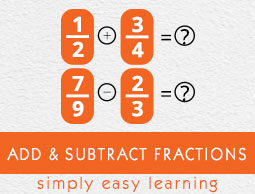
- Add and Subtract Fractions
- Home
- Add or Subtract Fractions With the Same Denominator
- Add or Subtract Fractions With the Same Denominator and Simplification
- Finding the LCD of Two Fractions
- Addition or Subtraction of Unit Fractions
- Addition or Subtraction of Fractions With Different Denominators
- Add or Subtract Fractions With Different Denominators Advanced
- Word Problem Involving Add or Subtract Fractions With Different Denominators
- Fractional Part of a Circle
Addition or Subtraction of Fractions With Different Denominators
Definition
When the denominators of any fractions are unequal or are different those fractions are called unlike fractions.
Operations like addition and subtraction cannot be done directly on unlike fractions.
These unlike fractions are first converted into like fractions by finding the least common denominator of these fractions and rewriting the fractions into equivalent fractions with same denominators (LCD)
When fractions with different or unlike fractions are to be added, first the least common denominator of the fractions is found. The equivalent fractions of given fractions are found with LCD as the common denominator. The numerators are now added and the result is put over the LCD to get the sum of fractions.
- We find the least common denominator of all the fractions.
- We rewrite the fractions to have the denominators equal to the LCD obtained in first step .
- We add the numerators of all the fractions keeping the denominator value equal to the LCD obtained in first step.
- We then express the fraction in lowest terms.
Subtracting unlike fractions − Formula
When fractions with different or unlike fractions are to be subtracted, first the least common denominator of the fractions is found. The equivalent fractions of given fractions are found with LCD as the common denominator. The numerators are now subtracted and the result is put over the LCD to get the difference of the given fractions.
- We find the least common denominator of all the fractions.
- We rewrite the fractions to have the denominators equal to the LCD obtained in step 1.
- We subtract the numerators of all the fractions keeping the denominator value equal to the LCD obtained in step 1.
- We express the fraction in lowest terms.
Problem 1
Add $\frac{1}{5}$ + $\frac{2}{7}$
Solution
Step 1:
Add $\frac{1}{5}$ + $\frac{2}{7}$
Here the denominators are different. As 5 and 7 are prime the LCD is their product 35.
Step 2:
Rewriting
$\frac{1}{5}$ + $\frac{2}{7}$ = $\frac{(1×7)}{(5×7)}$ + $\frac{(2×5)}{(7×5)}$ = $\frac{7}{35}$ + $\frac{10}{35}$
Step 3:
As the denominators have become equal
$\frac{7}{35}$ + $\frac{10}{35}$ = $\frac{(7+10)}{35}$ = $\frac{17}{35}$
Step 4:
So, $\frac{1}{5}$ + $\frac{2}{7}$ = $\frac{17}{35}$
Problem 2
Subtract $\frac{2}{15}$ − $\frac{1}{10}$
Solution
Step 1:
Subtract $\frac{2}{15}$ − $\frac{1}{10}$
Here the denominators are different. The LCM of 10 and 15 is 30.
Step 2:
Rewriting
$\frac{2}{15}$ − $\frac{1}{10}$ = $\frac{(2×2)}{(15×2)}$ − $\frac{(1×3)}{(10×3)}$ = $\frac{4}{30}$ − $\frac{3}{30}$
Step 3:
As the denominators have become equal
$\frac{4}{30}$ − $\frac{3}{30}$ = $\frac{(4−3)}{30}$ = $\frac{1}{30}$
Step 4:
So, $\frac{2}{15}$ − $\frac{1}{10}$ = $\frac{1}{30}$